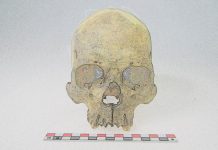
New research sheds light on the ancient roots of cultural interactions across the Tibetan Plateau, tracing these connections back to as early as the Bronze Age.
Despite its challenging environment, with an average altitude of 14,000 feet, the “roof of the world” has been home to humans since prehistoric times, where farming and herding have long been the backbone of the local economy.
In a study published in Scientific Reports, researchers utilized advanced geospatial modeling to delve into the environmental and archaeological evidence that reveals ancient mobility and subsistence strategies.
These strategies played a crucial role in fostering cultural connections among farmers and herders during the Bronze and Iron Ages, influencing the settlement pattern and the evolution of ceramic styles across the plateau.
The study, led by Michael Frachetti, a professor of archaeology at Washington University in St. Louis, was made possible by recent advancements in geospatial data analysis and high-resolution remote sensing.
The team created simulations to map out the optimal pathways used by ancient communities for farming and herding, based on the environmental capacity to support their livelihoods.
These pathways, often repeated across generations, showed a strong statistical correlation with the geographic locations of thousands of prehistoric sites across the Tibetan Plateau.
By compiling a vast database of archaeological findings from these sites, the researchers built a social network that highlights the interconnectedness of distant communities through shared technologies and designs of ceramics.
The analysis revealed “mobility highways” that facilitated not only the movement of people according to their subsistence needs but also played a pivotal role in establishing social relationships and shaping the regional character of ancient communities on the plateau.
An interesting aspect of the findings is the distinction between the western and eastern parts of Tibet. The western region did not follow the same patterns as the east, hinting at a different cultural orientation towards Central Asia.
This discrepancy suggests that mobility patterns and cultural connections might have varied significantly across the plateau, influenced by geographical and environmental factors.
Lead author Xinzhou Chen, who recently earned his doctorate from Washington University and now works at the Center for Archaeological Sciences at Sichuan University in China, emphasizes that this research offers a fresh perspective on the formation of human social cohesion in archaeology.
By exploring how ancient communities navigated and interacted within Tibet’s extreme terrain, the study contributes to a deeper understanding of the complex web of social relationships and cultural identities that have shaped human history on the Tibetan Plateau.
The research findings can be found in Scientific Reports.
Copyright © 2024 Knowridge Science Report. All rights reserved.



